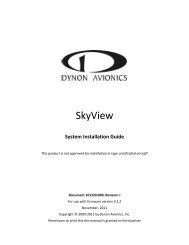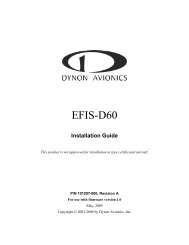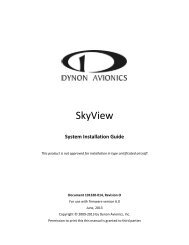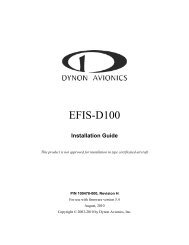EFIS-D100 Electronic Flight Information System - Dynon Avionics
EFIS-D100 Electronic Flight Information System - Dynon Avionics
EFIS-D100 Electronic Flight Information System - Dynon Avionics
You also want an ePaper? Increase the reach of your titles
YUMPU automatically turns print PDFs into web optimized ePapers that Google loves.
Available Pages<br />
During the first 30 seconds of operation, the altitude tape and digital readout are not displayed as the unit needs a small<br />
amount of time before altitude measurements are deemed accurate.<br />
Elevator trim indicator<br />
Located in the lower right corner of the <strong>EFIS</strong> page, the elevator trim indicator displays the relative trim of the<br />
elevator in graphic form. The elevator trim indicator can only be displayed on the <strong>EFIS</strong>-<strong>D100</strong> if an elevator<br />
trim sensor is properly connected to one of the 3 EMS GP inputs (on a DSAB-connected EMS device), and is<br />
properly configured in the EMS setup. As with the EMS info item, the green line indicates takeoff trim. The<br />
two arrows indicate the current elevator trim.<br />
Winds aloft arrow<br />
Located in the lower right corner of the <strong>EFIS</strong> page, the winds aloft arrow indicates the wind direction relative to<br />
your current direction of flight. The number indicates the current absolute wind speed in the current airspeed<br />
units. If the <strong>EFIS</strong>-<strong>D100</strong> cannot make an accurate winds aloft calculation, the arrow is not displayed and the<br />
numbers are replaced by dashes. The display of winds aloft requires an active GPS connection and an OAT<br />
probe. In very light winds, the wind speed number is not displayed, although the arrow is.<br />
Angle of attack (AOA) indicator<br />
The angle of attack indicator – available only with <strong>Dynon</strong>’s AOA Pitot Probe – displays the aircraft’s current<br />
AOA relative to the stall AOA. The AOA calibration process should result in the lowest angle of attack stall<br />
(usually the “clean” configuration) occurring between the yellow and red lines and the higher angle-of-attack<br />
stall (usually the “dirty” configuration) occurring at the top of the red. As your aircraft’s angle of attack<br />
increases, the bars in the indicator disappear, leaving the empty outline. As your aircraft’s AOA approaches<br />
stall, downward-pointing arrows are left. Depending on your installation and configuration, an audible alarm<br />
may also occur when near or in the stall. This audio alarm is accompanied by a flashing red triangle at the top of<br />
4-6 <strong>EFIS</strong>-<strong>D100</strong> Pilot’s User Guide
















